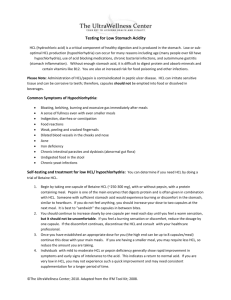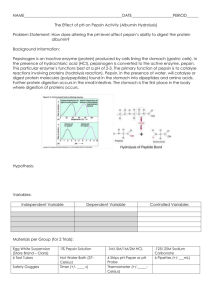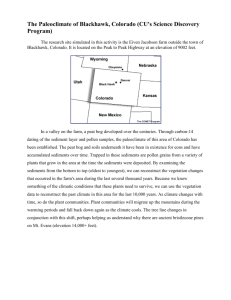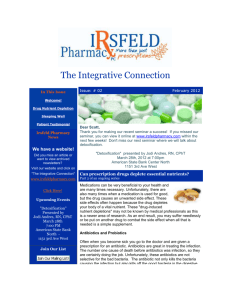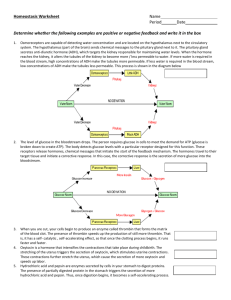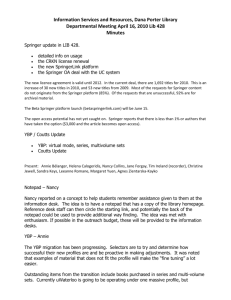Exposure to HCl/Pepsin (h)
advertisement
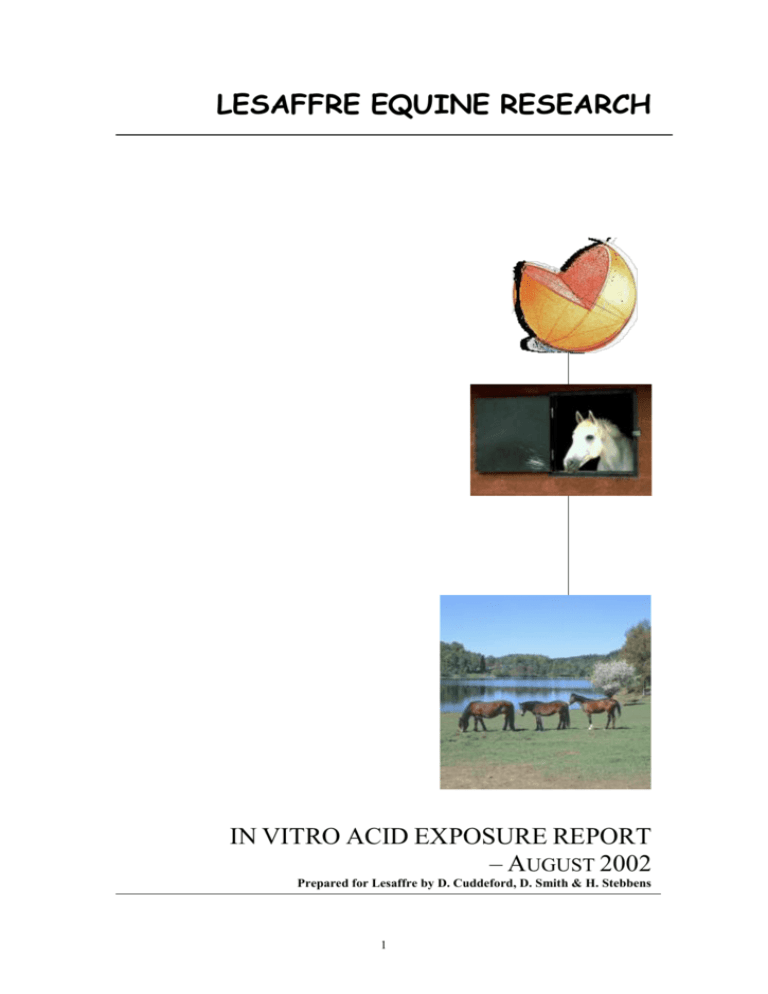
LESAFFRE EQUINE RESEARCH IN VITRO ACID EXPOSURE REPORT – AUGUST 2002 Prepared for Lesaffre by D. Cuddeford, D. Smith & H. Stebbens 1 In vitro measurement of hydrochloric acid /pepsin survival of commercial yeast based probiotic feed additives 1. Objective In monogastic herbivores such as the horse, yeast based probiotics (YBP) feed additives must survive exposure to acid digestion in the stomach if they are to pass through to the caecum (the site of action) in an active state.. This is not the case in ruminants where the site of action (rumen) is anterior to the site of acid digestion. The objective of this study was to determine the tolerance of YBP to acid conditions and still remain active. 2. Validation of gas production equipment 2.1 Equipment The equipment used to automatically monitor and measure gas pressure in incubation bottles was adapted from that of Pell and Schofield (1993). Each rubber-stoppered inoculum bottle was fitted with a pressure transducer (RS 286 –664 pressure range 015 psi) by way of a three way tap and a large bore (1.25 x 25mm) hypodermic needle. Each pressure transducer was then connected to a personal computer via a Pico ADC22 data logger (RS 375 –1717). The data was then displayed and stored on the computer with Picolog data logging software supplied with the ADC22. The ADC22 provided a maximum of 22 data channels, however the multi position stirrer that was used to agitate the contents of the bottles was limited to 15 positions. Therefore, only 15 of the available 22 channels were used for gas pressure measurements. One further channel was used to monitor inoculum temperature and another to monitor changes in atmospheric pressure, leaving five spare channels. 2.2 Initial calibration Each of the 15 pressure transducers was dedicated to a particular ADC channel, in order to avoid calibrations errors between channels. Before starting the study, each pressure transducer and channel (PTC) was calibrated by measuring the milli-volt 2 (mV) output of each transducer when the pressure differential (PD) between the atmosphere and the inoculum bottle was either 0 or 15 psi (the pressure at which full scale output was achieved on this particular design of transducer). A scaling table of mV against pressure in psi was then constructed for each PTC which was used to calibrate each channel using the scaling facility of the Picolog software. 2.3 Fine calibration In order to fine tune the calibration of each channel on a daily basis during the trial itself, the PD for each transducer at the start (T0) and the end (Tf) of the run was recorded using a digital pressure meter (DPM). Pressure readings at T0 and Tf from the transducer (PDt) and digital pressure meter (PDd) were then used to construct a data set of paired PDt and PDd readings for each PTC. Regression analysis was used to calculate a correction factor for each channel. The correction factors for each PTC was then used to convert all transducer measurements into digital pressure meter equivalents (DPME) so that all pressure readings could be directly compared on the same basis. 2.4 Transducer performance In order to evaluate relative transducer performance 15 clean autoclaved inoculum bottles were prepared by weighing 0.1 g of standard YBP (Biosaf Sc47 was chosen as a standard) into each bottle. The method described in section 5 (below) was then followed omitting acid exposure. Using this method the mean rate of gas production at T90 (time at 90% maximum gas production) was 0.62 (s.e. ± 0.027) psi/minute/g YBP. The coefficient of variation between PTC was measured to be 13.2 %. 3. Description of tested commercial yeast based probiotics A total of 13 YBP where tested during this trial. Five of the products tested where unidentified Lesaffre yeast products which were given the labels A to E. Another Lesaffre product, Biosaf Sc47 (BS), was also included in the products tested (Biosaf Sc47 was also used as a standard). Two of the Lesaffre products (A and B) were subdivided into three fractions based on the diameter of the spherules; less than 1mm (1), 1 – 1.6 mm (2) or more than 1.6 mm (3). 3 Three other commercially available YBP were tested,. These were Levucell Sc10 (LC) available from Agrimerica, Yea-Sacc (YS) available from Alltech Ltd. and XP Triple action (XP3) available from Dengie Crops Ltd. Microbiological, nutritional and physical descriptions of these products is summarised in Table 1. There were considerable differences between the nutritional analysis of the different YBP. In particular, non-Lesaffre YBP (LC, YS, XP3) showed large differences from the Lesaffre YBP. The fat content of LC was unusually high (43%) probably reflecting the protection method used with this product. The fibre content of YS (34%) and XP3 (17%) were much higher than any of the other YBP, probably reflecting the presence of residual culture substrate. All the non-Lesaffre YBP contained much less protein than the Lesaffre YBP, probably reflecting the diluting effect of non-yeast material, either residual substrate or protective ingredients. Added substrate Product name - trial code Other added micro-flora Table 1. Microbiological, nutritional and physical description of the range of commercial yeast-based probiotic additives tested Particle size (mm) Measured % DM Fat Fibre Ash Cited cfu/g Lesaffre - A1 Lesaffre - A2 Lesaffre - A3 Lesaffre - B1 Lesaffre - B2 Lesaffre - B3 Lesaffre - C Lesaffre - D Lesaffre - E Biosaf Sc47 - BS LevuCell Sc10 - LC XP Triple action - XP3 Yea-Sacc Sc1026 - YS Notes 1 Added microflora 1. Lactobacillus acidophilus, L. bulgaricus, L. plantarum, L. rhamnosus, Bifidobacterium bifidum, Enterococcus faecium, Streptococcus thermophilus, Aspergillus oryzae, Candida pintolopesii 2. Maize middlings, maize rye middlings, wheat middlings maize gluten free maize syrup, wheat syrup, cane molasses, fructo oligosaccharide 3. Corn, diastatic malt, cane molasses Added substrates 2 3 Protein < 1.0 1.0 – 1.6 > 1.6 < 1.0 1.0 – 1.6 > 1.6 <0.5 <0.5 <0.5 1.0 – 1.6 0.5 – 1.0 0.5 – 1.0 <0.5 4 1 x 109 40 1 3 5 1 x 109 40 0 3 5 1 x 109 1 x 109 1 x 109 1 x 109 2 x 1010 2 x 107 1 x 108 44 44 41 37 20 10 24 1 1 2 0 43 1 1 6 4 4 4 8 17 34 6 6 7 6 2 4 13 4. Quantifying the inherent gas production capacity of YBP 4.1 Background During this study, the principle used to compare the YBP was the time taken to metabolise (measured as gas production) a fixed amount of sucrose. Whilst most of the YBP tested in this studied consisted entirely of pelleted, purified yeast, XP3 and YS were exceptional in that they contained significant amounts of substrate, either added as part of the formulation (XP3) or as remnants of the culture media (YS) (Table 1). These substrates could contribute to the gas produced during fermentation resulting in a higher final gas pressure than that derived from sucrose alone. In order to quantify the differences in inherent gas production capacity (IGPC) between the YBP, three replicates of the following trial were carried out. 4.2 Materials and methods Sixteen inoculum bottles were autoclaved and dried in preparation for the trial. Thirteen of the inoculum bottles (100ml capacity) were labelled according to the trail codes listed in Table 1. Into each labelled bottle, 0.1g fresh weight (FW) of the appropriate YBP was added. A further 0.1g FW of YBP standard (STD) was weighed into the fourteenth bottle. No YBP was added to the last two remaining bottle, one of which was used as a blank (BLK) (in order to monitor incidental gas pressure changes during the incubation) and the other (TEMP), was used to monitor inoculum temperature during the incubation. 20ml of standard solution (appendix 1) were added to each of the 16 bottles, followed by 40 ml of inoculum buffer (appendix 1). A sterilized magnetic stirring bar was placed in to each bottle apart from the TEMP bottle. Each bottle (apart from TEMP) was sealed with a sterilized rubber stopper and secured with an aluminium sealing ring. All bottles were then placed in the incubator. The brass temperature sensor was placed in the TEMP bottle which was then place at the back of the incubator, away from the magnetic stirring platform. All the other bottles were connected to the corresponding pressure transducer in the incubator by way of a wide bore hypodermic needle (1.25 x 25mm) and the exhaust vent of the 3-way tap on each transducer was closed and sealed with a greased plug. Each bottle was then placed in the incubator 5 over a magnetic stirring position. The stirring revolutions of the magnetic stirrer were adjusted to about 260 per minute. The incubator door was then closed. Immediately after the incubator door was closed, the starting pressure of each PTC (PDt – 0) was recorded on the daily record sheet. At this stage the start time and ambient atmospheric pressure (hPa ) measured by electronic barometer were also logged. After PDt-0 had been manually recorded automatic recording was initiated; PDt was recorded every 10 minutes for a period of 24 hours. Data collection was programmed to stop automatically after 150 data points per PTC had been collected and the data was saved to the hard disk of the computer. Atmospheric pressure at the end of the data collection period was manually recorded on the daily datasheet. Timed maximum and minimum atmospheric pressures during the previous 24 hours were also recorded on the daily datasheet, using the history function of the electronic barometer. Once PTC data had been saved to the computer hard disk, the final pressure of each bottle was measured with DPM (PDd-F) and recorded on the daily record sheet. Data from the Picolog files were then copied over to a Microsoft Excel template files, and PDt - 0 and PDd – F were entered onto the spread sheet in order to convert all PTC measurements to DPME. 4.3 Results and discussion Overall the amount of the maximum gas pressure was derived from IGPC of the YBP tested was not significant (Table 2). Furthermore, The IGPC of the three products with added or residual substrate (LC, XP3 and YS) were not significantly different the Lesaffre products that did not contain added substrate. 4.4 Conclusion As the IGPC of the range of commercial products were not significantly different from each other and as there was not significant increase in overall gas production it was not necessary to develop a correction factor to account for IGPC. 6 Table 2. Inherent gas production capacity of a range of commercial yeast based probiotic additives Product name - trial code Inherent gas production (IGPC) (PSI per g YBP) Lesaffre - A1 Lesaffre - A2 Lesaffre - A3 Lesaffre - B1 Lesaffre - B2 Lesaffre - B3 Lesaffre - C Lesaffre - D Lesaffre - E Biosaf Sc47 - BS LevuCell Sc10 - LC XP Triple action - XP3 Yea-Sacc Sc1026 - YS Mean s.d. 3.1 2.7 1.9 2.2 1.2 1.3 2.7 1.5 1.6 1.8 1.8 2.5 2.6 2.1 0.61 Max gas production after fermentation with 0.3 g of added sucrose (PSI per g YBP) 69.7 75.3 63.3 66.5 68.7 72.7 66.1 65.4 67.7 61.8 52.6 91.2 77.0 69.1 9.11 Max production resulting from IGPC (%) 4.4 3.6 3.1 3.3 1.8 1.7 4.1 2.3 2.4 2.9 3.4 2.8 3.3 3.0 0.81 5. Evaluation of the survival characteristics of commercial yeast-based probiotics 5.1 Background The efficacy of YBP in the hind gut is thought to depend on them surviving the acid conditions of the stomach. In order to compare the effect of acid exposure on the viability of different commercial YBP, a trial was conducted in which rate of gas production was used to determine the extent of yeast survival. In order to compare the activity of YBP, each product was ranked against the others in terms of both survival rate and actual gas production rate after each of the allotted exposure times to acidic conditions. 5.2 Materials and methods The restricted capacity (15 inoculum bottles) limited the opportunity for within-run replication. The most effective way to carry out the trial was to treat each batch of 13 YBP with a single HCl/pepsin exposure and include a standard unexposed YBP (STD) in the run allowing comparisons between runs. Each HCl/pepsin exposure was carried out in duplicate, to provide a measure of the within YBP variation. 7 Eight exposure times to HCl/pepsin digestion were tested and these were 0, 15, 30, 45, 60, 120 minutes. Each exposure time was tested in quadruplicate using analysis of gas production data to compare the effect of HCl/pepsin exposure time on YBP activity. Sixteen inoculum bottles were autoclaved and dried in preparation for the trial. Thirteen of the inoculum bottles (100ml capacity) were labelled according to the trial codes listed in Table 1. Into each labelled bottle, 0.1g FW of the appropriate YBP was added. A further 0.1g FW of YBP standard (STD) was weighed into the fourteenth bottle. No YBP was added to the last two remaining bottle one of which was used as a blank (BLK) (in order to monitor incidental gas pressure changes during the incubation) and the other (TEMP) was used to monitor inoculum temperature during the incubation period. Bottles labelled STD, BLK and TEMP were set aside from the other bottles to avoid accidental exposure to HCl/Pepsin. All other bottles were placed in a shallow water bath and incubated at 39ºC. A solution of pepsin in 0.1 N HCl was prepared by dissolving 2g of 1:10,000 pepsin (BDH Ltd.) in 850 ml of distilled water. 100ml of 1N HCl was then added and the solution made up to 1 litre with water. This solution was then warmed in a water bath until the HCl/pepsin solution attained the incubation temperature (39ºC). As previously described above only a single HCl/pepsin exposure time was carried out for each batch of inoculum bottles. For the 15, 30, 45, 60, 120, 180, 240 minute exposure 20 ml of the warmed (39ºC) HCl/pepsin solution was added to each of the inoculum bottles in the water bath (NB this did not include STD, BLK or TEMP). After the allotted exposure time had passed, the HCl/pepsin solution was neutralised by adding 2ml of 1N Na2CO3 solution to each inoculum bottle which were then shaken by hand. The temperature of inoculum bottles was then rapidly reduced to below room temperature by adding copious amounts of ice to the water bath. The 0 min exposure batch and the STD, BLK and TEMP inoculum bottles in all batches were treated differently from the YBP bottles that were exposed to HCl/pepsin. In order to make the volume of liquid in each bottle equal to the bottles that had been exposed to acid, 20 ml of a standard solution (pepsin in 0.1 N NaCl – see appendix 1) was added to each bottle. The pepsin in 0.1 NaCl was chemically 8 identical to the resultant mixture of HCl/pepsin and Na2CO3 that had been added during the other tests but did not expose the YBP to extremes in pH or active enzymes. 800 ml of inoculum buffer were prepared as described in appendix 1 and 6g of sucrose was then added. Once the sucrose was dissolved in the inoculum buffer, 40 ml of the solution was added to each of the 16 inoculum bottle bottles (13 bottles containing YBP, plus STD, BLK and TEMP). A sterilized magnetic stirring bar was placed in each bottle apart from the TEMP bottle and then sealed with a sterilized rubber stopper and secured with an aluminium sealing rings. Thereafter, the procedure was as described in 4.2. Raw PTC data from the Picolog Data Recorder program including a record of ambient atmospheric pressure and inoculum temperature at the time of each PTC reading were imported into an Excel spreadsheet template. The specially developed template automatically calibrated each channels output to DPME (as described in section 2.3), corrected each data entry from ambient atmospheric pressure to a standard atmospheric pressure (1000 h Pa), ambient inoculum temperature to a standard inoculum temperature (39°C) and actual YBP sample weight to a standard sample weight (0.1 g FW). The template also rescaled the data so that all pressure readings were positive. Data modelling and statistical analysis Genstat for Windows 6th Edition/ Release 6.1 (Lawes Agricultural trust, 2002) was used to fit sigmoid, monotonic growth curves to the calibrated and rescaled gas production data. A single phase logistic model was selected because of the simplicity of the biological system being investigated (consisting of a single organism and a single substrate). The applied model was as follows: Ym Y Y0 ( R * ( X M )) 1 e Equation 1 where Y is gas pressure at X, Y0 is the lower asymptote, Ym is the upper asymptote, R is the fractional growth rate, X is time after incubation began and M is the time of maximum growth. The Genstat analysis provided an estimation of the parameters Y0, Ym, R and M, as well as the percentage variation within the data set accounted for by 9 the model parameters. Models that accounted for less than 95% of the variation within the data sets and which had a total estimated pressure change (ΔPe, equivalent to Ym + Y0) that varied from the total measured pressure change (ΔPm) by more than 10% were rejected for inclusion in any further analysis; at least four replicates were used to calculate each mean. Preliminary analysis showed that pepsin/HCl exposure effected both the time to maximum growth (M) and the total pressure change ΔPe. In order to provide a unified estimate on the effect of pepsin/HCl exposure on the two interacting model parameters M and ΔPe a composite parameter referred to as linear rate at 50% of total gas production (LR50) was calculated. It can be demonstrated from Equation 1 that 50% of the total gas production is produced when time after incubation (X) is equal to M. Therefore M provides an estimate of the time taken to produce 50% of the total gas pressure and LR50 can be calculated from by using the equation ½ ΔPe/M. In order to provide sufficient replicates for statistical analysis, pepsin/HCl exposure time treatments were grouped into the following classification 0 minutes exposure, 15 – 30 minutes exposure, 45 – 60 minutes exposure and more than 120 minutes. This provided 8 replicates of each exposure time for each product. Uni-variate Analysis of Variance (ANOVA) and Multivariate Analysis of Variance (MANOVA) was carried out on the grouped exposure data. 5.3 Results and discussion Accuracy of modelled curves Models that did not account for 95% of the variation in the data set and had a ΔPe that deviated from ΔPm by more than 10% were rejected. The model used to describe the gas production curves (equation 1) contained four separate constants, two of these (Y0 and Ym) could be readily estimated from the raw gas production data plotted against time whilst the other two (R and M) could not. As the sum of Y0 and Ym is equal to ΔPe, the accuracy of the modelling procedure was evaluated using regression analysis of ΔPe with ΔPm. The result of this analysis is shown in Figure 1. The r2 values for the regression analysis (0.99) was very high, the line of best fit predicted by the 10 11 regression analysis had an intercept close to 0 (0.177) and a slope close to parity (1.0099). The result of this analysis indicates that the models used in the subsequent statistical analysis were a very accurate description of the real data. Summaries of treatment effects (exposure times and products) on measured and estimated (modelled) parameters are shown in Table 3. The means for both exposure times and products treatments are confounded by each other and do not provide accurate cross-product or cross-exposure time comparisons, however they are included in this report for completeness. Comparison of YBP after no exposure to pepsin/HCl Figures 2, 3, 4 and 5 compares ΔPm, ΔPe, M and R of each YBP after no exposure to pepsin/HCl. When ΔPe, M and R are used to produce gas production curves for each YBP (Figure 7) distinct differences can be seen between products, particularly between Lesaffre and non-Lesaffre products. However, these differences were not necessarily reflected in the statistical differences between single curve modelling parameters such as R, M and ΔPe (Figures 3-5). The only significant difference between STD and the other YBP in values of ΔP e was in the case of B2 (P<0.05). The parameters R and M showed more significant differences between YBP. In the case of parameter R, STD was significantly different from LS (P<0.05) and YS (P<0.05). All other paired comparisons were not significant. Parameter M also showed significant differences between YBP. The STD and all Lesaffre products had significantly lower M values (P<0.001) than either YS or XP3. LS had consistently higher values of M than any Lesaffre product, but these were not statistically significant. There were also significant differences (P<0.05) in LR50 between STD and the three non-Lesaffre products (LS, XP3 and YS). Spherule size, as test by comparison between YBP A1 - A3 and between B1 – B3 had no significant effect on any of the four curve modelling parameters. 12 13 The effect of pepsin/HCl exposure on YBP activity Total pressure change (ΔPm and ΔPe) Overall increasing exposure time to pepsin/HCl had a significant (P<0.001) and progressive effect on ΔPm (Table 3). Between 15 –30 minutes pepsin/HCl exposure significantly (P<0.001) reduced ΔPm, but there was no additional significant decrease in ΔPm when exposure time was increased to between 45 – 60 minutes. Exposure times of above 120 minutes significantly (P<0.001) depressed ΔPm still further. The ΔPm of some YBP were less effected by pepsin/HCl exposure than others. The ΔPm of XP3 was least effected by exposure to pepsin/HCl followed by LS (Figure2). The pattern of effect of exposure to pepsin/HCl on ΔPe was similar to the effect on ΔPm (Figure 3) reflecting the close relationship between the two parameters that was discussed in the previous section. Time to maximum growth (M) The effect pepsin/HCl exposure on M was inverse to that of ΔPm and ΔPe - as exposure time increased M increased (Figure 4). In the case of Lesaffre products increasing pepsin/HCl exposure time from 0 minutes to 15 –30 minutes had the greatest effect on increasing M, subsequent increases in exposure time had less effect. Differences in M after 45-60 minutes exposure were not significantly different from more exposure times of than 120 minutes. The M values of non-Lesaffre products (LS, XP3 and YS) were not significantly effected by pepsin/HCl exposure time. Fractional rate of gas production (R) The effect of pepsin/HCl exposure time on R was not clear cut. For all Lesaffre products R decreased significantly (P<0.001) when pepsin/HCl exposure increased from 0 minutes to 15-30 minutes (Figure 5). However further increases in exposure times has an ambivalent effect depending on the YBP, in some cases there was a further decrease in rate whilst in others rate increased. Generally where exposure time exceeded 0 minutes, within a YBP there were no significant effects of increased pepsin/HCl exposure. 14 15 16 17 18 Initial it was anticipated that R values would provide a good unambiguous measure of the effect of pepsin/HCl exposure on YBP. However, this study has shown that the above 0 minutes exposure there is no consistent effect of pepsin/HCl exposure on R, whilst the effects on ΔPe and M were significant and consistent. This is probably due to the complex way in which R influences the gas production curve, essentially defining the shape of the curve, but not influencing the total gas production or the time to maximum growth. On balance it was decided the R was not sufficiently sensitive measure to compare exposure treatments or products. Linear Rate at 50% of total gas production (LR50) Linear rate of total gas production (LR50) provided a composite measure of both ΔPe and M (Figure 6). The effect of pepsin/HCl exposure was to significantly (P<0.001) reduce LR50 in the Lesaffre products but not in the non-Lesaffre products (LS, XP3 and YS). However, initial LR50 values (0 minutes exposure) were much higher than in the Lesaffre products than the non-Lesaffre products. After 15-30 minutes exposure to pepsin/HCl differences in LR50 between Lesaffre products and nonLesaffre products was reduced. After 120 minutes exposure to pepsin/HCl there was no significant difference between YBP. Lesaffre products were more sensitive to pepsin/HCl than non-Lesaffre products. After 120 minutes of exposure the YBP with the highest activity were LS, XP3 and BS. The LR50 values of XP3 remained virtual unchanged by pepsin/HCl exposure, however its initial levels of activity were the lowest of any YBP. Gas production curves The effect of pepsin/HCl exposure on gas production curves can be seen in Figures 7 –10. These provide an overall picture of the interaction of ΔPe, M and R. The effect of pepsin/HCl exposure can be seen by comparing the curves for each exposure time with the curve for STD. After 15-30 minutes (Figure 8) exposure all products with exception of XP3 had been effected by the pepsin/HCl, curves become flatter with a lower total gas production. This trend continued as exposure time increased. After more than 120 minutes exposure (Figure 10) the curves of three products (BS, LS and XP3) were quite distinct from the other products reflecting higher ΔPe, M and R that was discussed in the previous section. 19 In this visual analysis BS is the YBP that maintains the highest activity after 120 minutes exposure to pepsin/HCl, achieving a similar ΔPe, to XP3 but much sooner, indicating higher viable cell activity after exposure. LS also maintained a high level of activity than XP3 after 120 minutes exposure. XP3 appeared largely unaffected by pepsin/HCl exposure but had low levels of activity even after no exposure to pepsin/HCl. Conclusion Pepsin/HCl exposure had a activity suppressing effect in all YBP apart from XP3. Lesaffre products with the exception of BS were more highly sensitive to pepsin/HCl exposure than non-Lesaffre products, but had higher initial activity levels when not exposed. BS was the Lesaffre product with the best survival characteristics and was the most active of all the YBP even after 120 minutes exposure to pepsin/HCl. XP3 was the product with the lowest level of activity after no exposure to pepsin/HCl but was the product least effected by pepsin/HCl exposure. LS was the best performing non-Lesaffre product, which maintained high level of activity similar to BS even after 120 minutes exposure to pepsin/HCl. 20 21 22 23 24 Appendix 1 – Reagents Buffer Solution A - Stock KH2PO4 MgSO4·7H20 NaCl CaCl2·2H20 Urea (reagent grade) Store at 4ºC until required g/litre 10.0 0.5 0.5 0.1 0.5 Buffer Solution B - Stock Na2CO3 Na2S·9H20 Store at 4ºC until required g/litre 15.0 1.0 Inoculum buffer – Prepare daily Buffer solution A from stock Buffer solution B from stock Adjust to Ph 6.8 @ 39ºC 600 ml 120 ml Pepsin in HCl HCl 0.1 N from stock – Prepare daily Pepsin 1:10,000 350 ml 0.7 g Stopper – Stock (10% Na2CO3) Na2CO3 Distilled water Make up to 100ml with distilled water in volumetric flask 10.0 g 95 ml Sucrose solution – Prepare daily Sucrose Inoculum buffer 6.0 g 20 ml Standard solution – Stock (Pepsin in 1 N NaCl) NaCl 5.8 g Pepsin 1:10,000 2.0 g Distilled water 950 ml Make up to 1000ml with distilled water in volumetric flask 25

